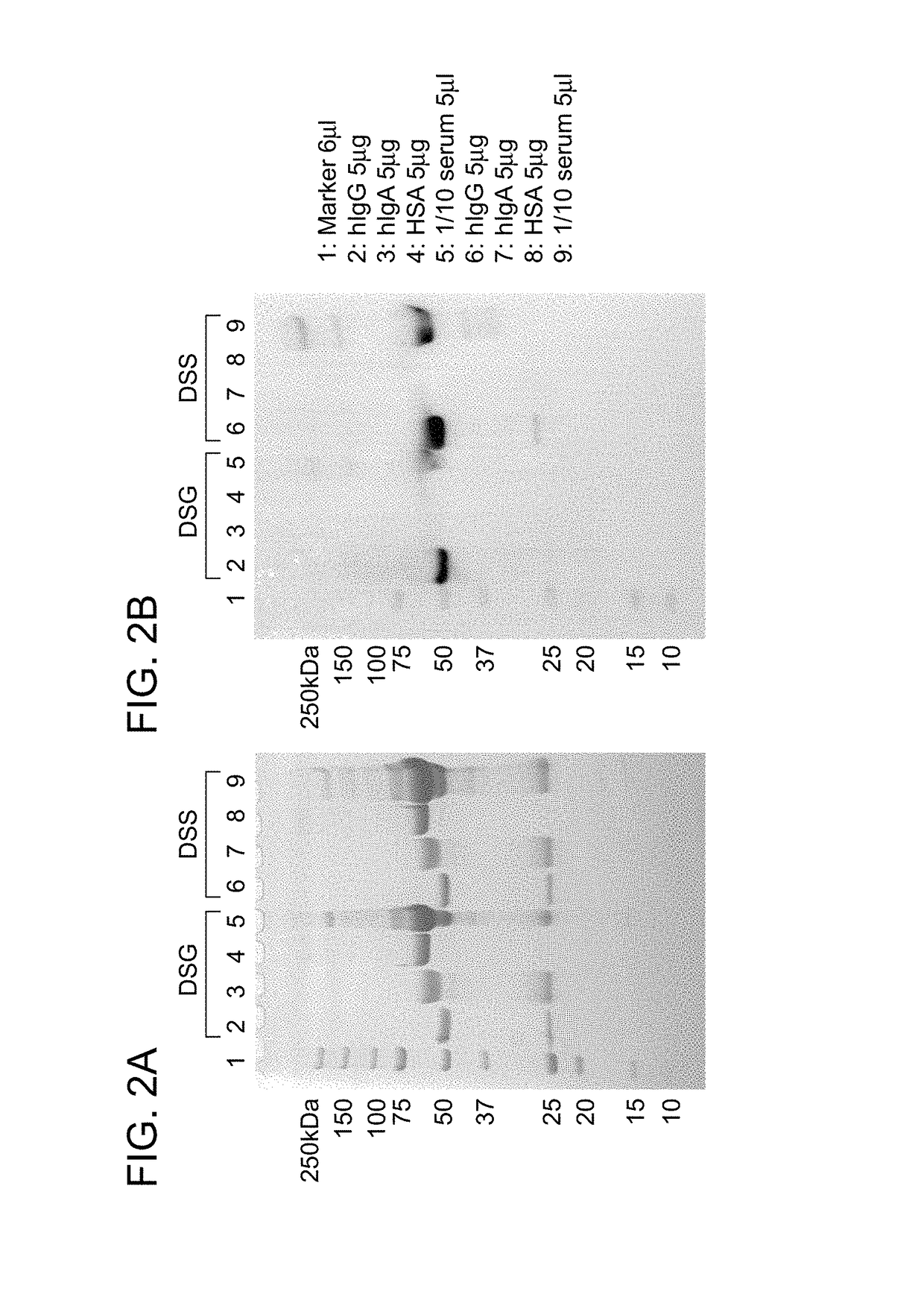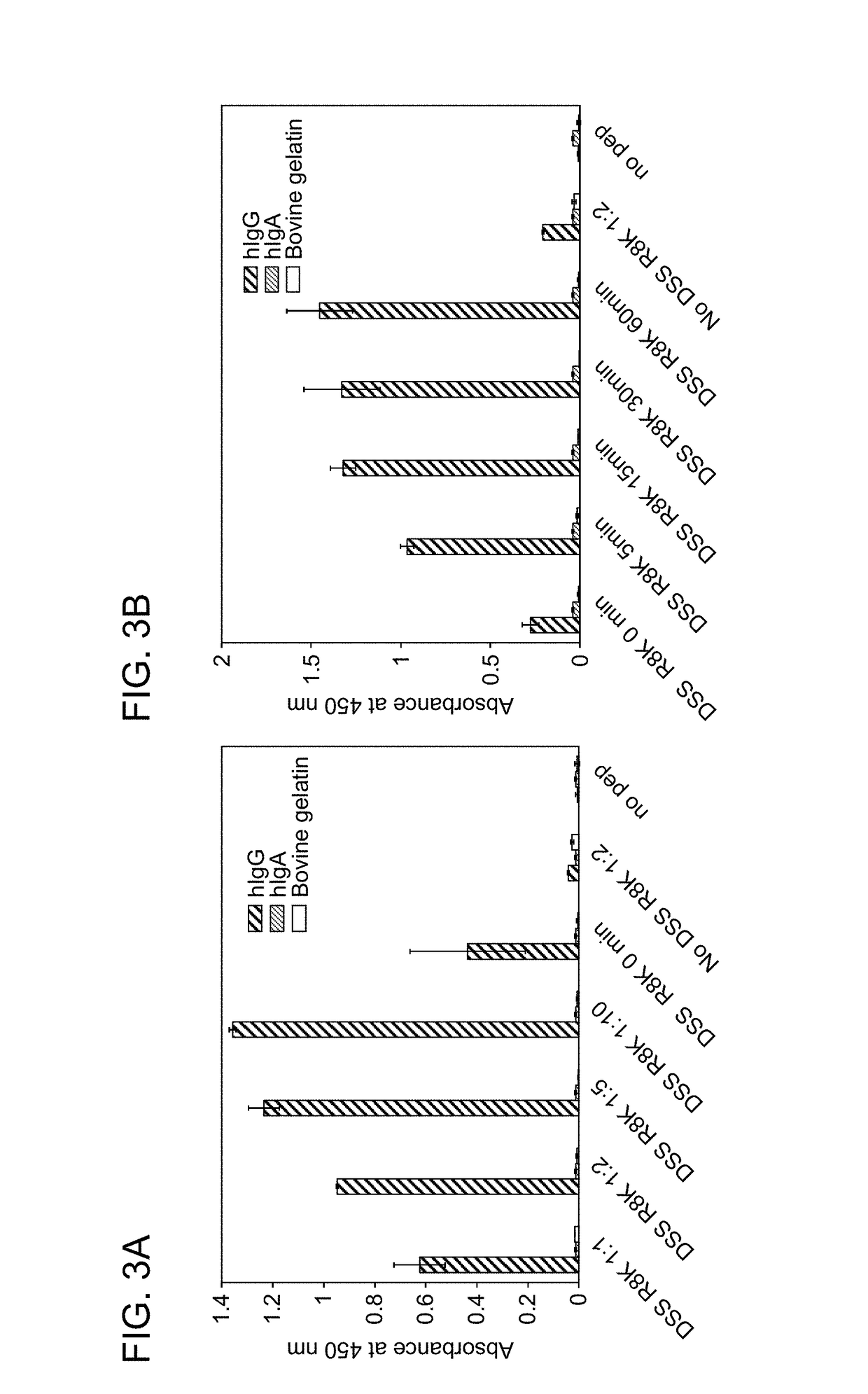Specific modification of antibody with IgG-binding peptide
a technology of igg-binding peptide and specific modification, which is applied in the field of igg-binding peptide, can solve the problems of weakening the activity of antibodies themselves, difficult control of the number of compounds to be bound, and reducing the activity of antibodies, etc., and achieves short time, short side reactions, and modification specific and convenient
- Summary
- Abstract
- Description
- Claims
- Application Information
AI Technical Summary
Benefits of technology
Problems solved by technology
Method used
Image
Examples
example 1
stallography of Conjugate of IgG-Binding Peptide and IgG
(1) Preparation of IgG-Binding Peptide Solution
[0123]A cyclic homocysteine peptide having the sequence of G(HC)DCAYHRGELVWCT(HC)H-NH2 (SEQ ID NO: 31, wherein HC represents homocysteine, and the two Cys residues at positions 4 and 14 and the two homocysteine residues at positions 2 and 16 respectively formed intramolecular disulfide bonds) was prepared according to a routine method by the solid-phase peptide synthesis method based on the Fmoc method. A powder of 0.8 mg of the prepared IgG-binding peptide was dissolved in 24 μL of 100% dimethyl sulfoxide (Wako Pure Chemical Industries, Ltd.) to prepare an IgG-binding peptide solution.
(2) Preparation of Conjugate of Fc and IgG-Binding Peptide
[0124]The hinge moiety of human IgG (Chugai Pharmaceutical Co., Ltd.) was cleaved using papain (manufactured by F. Hoffmann-La Roche, Ltd.) at 37° C. in a 20 mmol / L phosphate buffer solution (pH 7.0) containing 10 mM EDTA and 1 mM L-cysteine. ...
example 2
on and Properties of Peptide for Labeling
[0130]An amino-PEG4-added synthetic peptide GPDCAYHXGELVWCTFH (SEQ ID NO: 2) (C-terminally amidated) with the amino group modified with biotin or 5 / 6 TAMURA succinimidyl ester (AnaSpec, Inc.) (fluorescent dye) was synthesized according to a routine method by the Fmoc solid-phase synthesis method. After removal of protective groups, an intramolecular S—S bond was formed under oxidative conditions in an aqueous solution of pH 8.5. The peptide having the intramolecular S—S bond was purified using reverse-phase HPLC by gradient elution of 10% to 60% acetonitrile containing 0.1% TFA at a flow rate of 1.0 ml / min.
[0131]100 μL of a DMF solution containing 1 mM of the purified IgG-binding peptide was mixed with 100 μL of an acetonitrile solution of 100 mM DSS or DSG (Thermo Fisher Scientific Inc.), and the mixture was then reacted overnight at room temperature. The reaction product was diluted 2.5-fold with 0.1% TFA and then injected to Bondasphere 5 ...
example 3
Modification of Human IgG-Fc with IgG-Binding Peptide
[0135]A labeled reagent peptide was prepared in the same way as in Example 2 by modifying a N-terminally biotin-PEG4-added IgG-binding peptide (Type I(R8K)) with DSS or DSG. This peptide was reacted with human IgG Fc to study the labeling reaction of the human IgG Fc. Specifically, an IgG-binding peptide (R8K) (200 pmol / 5 μL in 0.1% TFA) reacted with an excess of DSS or DSG in the same way as in Example 2 was purified with a reverse-phase column, followed by the removal of acetonitrile under reduced pressure. Then, the purified product was neutralized by the addition of 0.5 M Na2HPO4 in an amount of approximately 1 / 8 and immediately added at a molar ratio of 10 times to a protein sample (hIgG (Chugai Pharmaceutical Co., Ltd.), hIgA (Athens Research & Technology, Inc.), HAS (Sigma-Aldrich Co. LLC), or serum (collected from a healthy person)) (40 pmol / 5 μL for each sample; the serum used was diluted 10-fold with PBS). After adjustme...
PUM
| Property | Measurement | Unit |
|---|---|---|
| length | aaaaa | aaaaa |
| pH | aaaaa | aaaaa |
| molar ratio | aaaaa | aaaaa |
Abstract
Description
Claims
Application Information
 Login to View More
Login to View More - R&D
- Intellectual Property
- Life Sciences
- Materials
- Tech Scout
- Unparalleled Data Quality
- Higher Quality Content
- 60% Fewer Hallucinations
Browse by: Latest US Patents, China's latest patents, Technical Efficacy Thesaurus, Application Domain, Technology Topic, Popular Technical Reports.
© 2025 PatSnap. All rights reserved.Legal|Privacy policy|Modern Slavery Act Transparency Statement|Sitemap|About US| Contact US: help@patsnap.com



